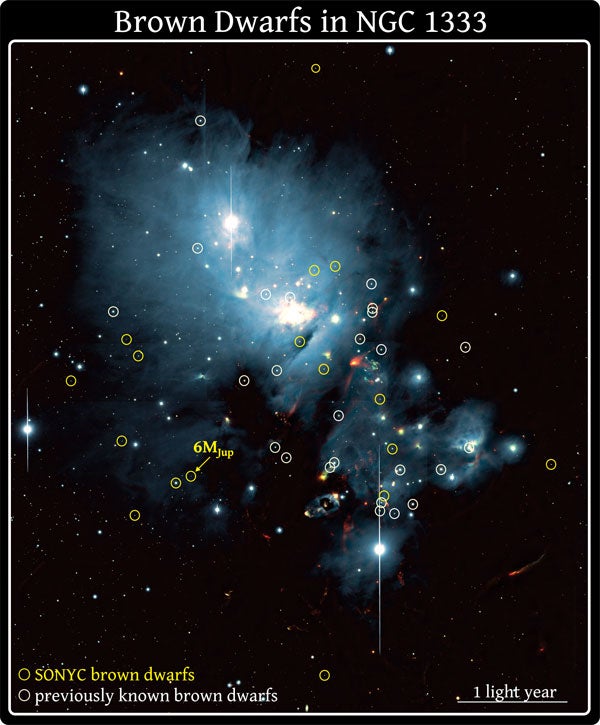Sometimes described as failed stars, brown dwarfs are unusual celestial objects that straddle the boundary between stars and planets. When young, they glow brightly from the heat of formation, but they eventually cool down and end up with atmospheres that exhibit planet-like characteristics.
During the course of the Substellar Objects in Nearby Young Clusters (SONYC) Survey, astronomers used the Subaru Telescope to take deep images of NGC 1333 and the Rho Ophiuchi star cluster at both optical and infrared wavelengths. Once they identified candidate brown dwarfs from their red colors, the research team verified their nature with spectra taken at Subaru and the VLT.
The six-Jupiter-mass brown dwarf found in the NGC 1333 cluster is one of the puniest free-floating objects known. “Its mass is comparable to those of giant planets, yet it doesn’t circle a star. How it formed is a mystery,” said Aleks Scholz from the Dublin Institute for Advanced Studies in Ireland.
Several other newly identified brown dwarfs in both the NGC 1333 and Rho Ophiuchi clusters have masses that are less than 20 times the mass of Jupiter — placing them at the low end of the mass range for known brown dwarfs. “Brown dwarfs seem to be more common in NGC 1333 than in other young star clusters. That difference may be hinting at how different environmental conditions affect their formation,” said Koraljka Muzic from the University of Toronto in Canada.
“Our findings suggest, once again, that objects not much bigger than Jupiter could form the same way as stars do. In other words, nature appears to have more than one trick up its sleeve for producing planetary-mass objects,” said Ray Jayawardhana from the University of Toronto.
Sometimes described as failed stars, brown dwarfs are unusual celestial objects that straddle the boundary between stars and planets. When young, they glow brightly from the heat of formation, but they eventually cool down and end up with atmospheres that exhibit planet-like characteristics.
During the course of the Substellar Objects in Nearby Young Clusters (SONYC) Survey, astronomers used the Subaru Telescope to take deep images of NGC 1333 and the Rho Ophiuchi star cluster at both optical and infrared wavelengths. Once they identified candidate brown dwarfs from their red colors, the research team verified their nature with spectra taken at Subaru and the VLT.
The six-Jupiter-mass brown dwarf found in the NGC 1333 cluster is one of the puniest free-floating objects known. “Its mass is comparable to those of giant planets, yet it doesn’t circle a star. How it formed is a mystery,” said Aleks Scholz from the Dublin Institute for Advanced Studies in Ireland.
Several other newly identified brown dwarfs in both the NGC 1333 and Rho Ophiuchi clusters have masses that are less than 20 times the mass of Jupiter — placing them at the low end of the mass range for known brown dwarfs. “Brown dwarfs seem to be more common in NGC 1333 than in other young star clusters. That difference may be hinting at how different environmental conditions affect their formation,” said Koraljka Muzic from the University of Toronto in Canada.
“Our findings suggest, once again, that objects not much bigger than Jupiter could form the same way as stars do. In other words, nature appears to have more than one trick up its sleeve for producing planetary-mass objects,” said Ray Jayawardhana from the University of Toronto.










